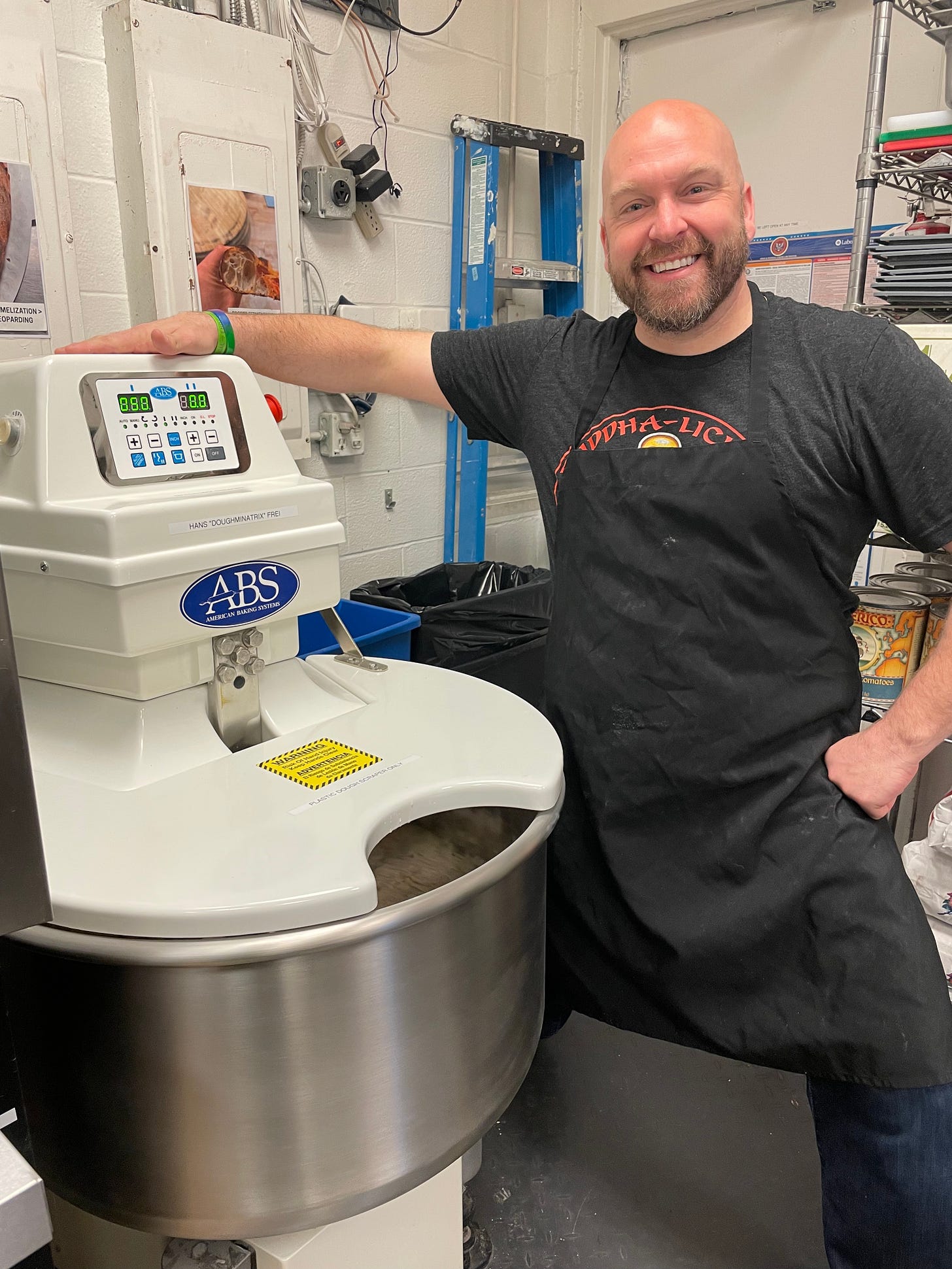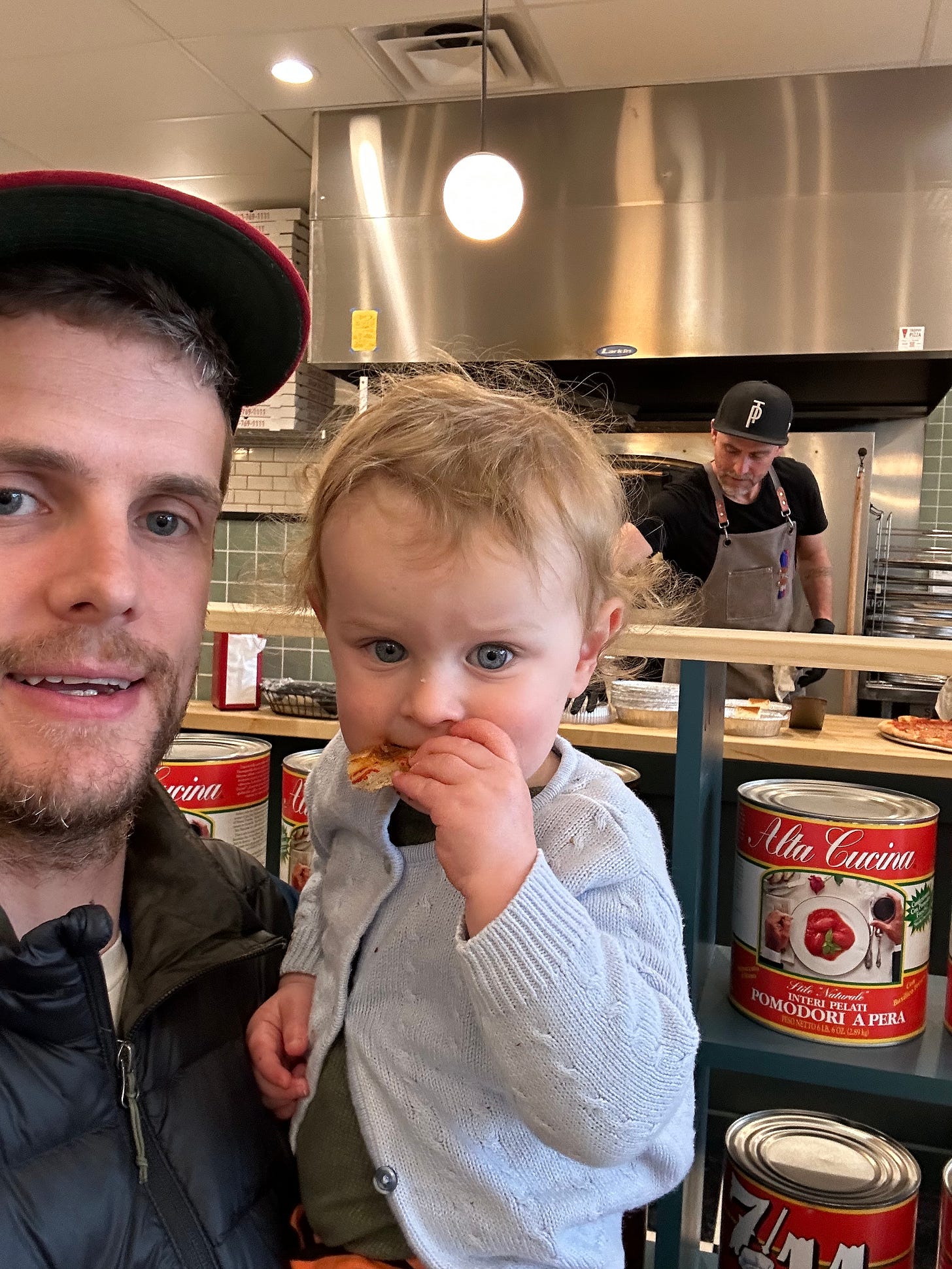I'm the owner of the pizza restaurant Saint Francis Apizza in Cincinnati, OH. I write a newsletter most months to send out updates about the pizzeria, share my love of pizza and the travels I embark on to learn more about my favorite food, and the business behind it.
It takes more than a high rate of pizzerias per capita to qualify a city as having ‘pizza scene.'
There are the obvious elements like multiple ‘styles’ done well. Can I drive around town and enjoy Detroit, New York, Neapolitan, etc. any day of the week? It’s nice to have those options, and someone had to go out and more or less master whichever one they’re focused on — no small feat. It certainly makes life richer for the pizza consumer (it takes one to know one).
More than just featuring various styles of pizza, a pizza scene is marked by pizzerias each having a unique perspective on pizza. These are pizza makers with a personal take on what pizza ought to be. There’s a specific pizza they love to eat most, whether it’s what brought them comfort growing up, or one they encountered in a hole-in-the-wall in Rome. Then, they dedicate themselves to bringing it to all of us, directing their own little pizza masterpiece.
If a small city like Cincinnati is home to just two New York-style pizza places lead by people with different perspectives on what great New York-style pizza is, then we’re all lucky because the pizza scene isn’t just broad, it’s deep.
So, for the pizza-loving consumer, the more the merrier! But how do pizza shops see it? What does it mean to co-exist?

Pizza Scene Dynamic A: Cooperation
There are two kinds of people in the pizza business: those who freely share information about their pizza, and those who fight like hell to keep the details secret. I’ve heard stories of pizza makers digging through dumpsters to figure out what’s in a ‘secret sauce.’ I’ve been the recipient of subtle but deliberate attempts by insecure pizza makers to discourage me, to make me feel small. These are shortsighted responses to competition.
Fortunately, those type of things aren’t the norm in Cincinnati or nationally. I’m on the younger side of the pizza shop owner spectrum. People like Brian Spangler of Apizza Scholls, Tony Gemignani, John Arena of Metro Pizza, Chris Bianco, and many, many more, set the example by being completely ‘open-book’ about everything they’ve learned through decades of experience, from their exact dough recipes to the financial ratios to operate within to endure in this business half as long as they have. I’m not exaggerating: all of them have in some form published their actual dough recipe and process, in some cases without writing a cookbook (so with no direct financial gain). Google it!
They do make some of the best pizza in the world, but they are legends because they share with open hearts.
Portland, Oregon is a top three/four pizza city in the USA, yet that’s still a little-known fact. Growing up there and following the Portland pizza scene from afar in the years leading up to opening my own place in Cincinnati, I remember a prominent, successful pizzeria owner being asked how so many quality pizza places can co-exist in one small city.
It’s a dynamic of ‘co-opetition,’ he explained.
Of course each pizza shop wants to be recognized, to catch on, and to become a staple.Most pizzeria owners I know personally in Portland are driven by those aspirations, but manage to do so without resentment or wishing ill on their peers.
In terms of the community or cooperation aspect of ‘co-opetition,’ they freely exchange best practices, spend money at each other’s shops, and speak well of one another. I admit that I don’t completely know what is said away from microphones and behind backs, but speaking from personal experience meeting and eating pizza with some of the best pizza makers in Portland, Chicago, and New York, there isn’t much trash being talked, just some harmless gossip here and there.
Here in Cincinnati, I felt relieved and encouraged listening to Dave Willocks, chef/owner of The Baker’s Table here in the Cincinnati area, on the Spoon Mob podcast, describe the Cincinnati pizza scene by saying that there are a number of independent pizzerias each doing their own thing in their own neighborhood. We all have our own area around our shop, with some areas of overlap, but many of us eat pizza at each other’s restaurants on a night off, exchange personal check-ins and send customers to one another when the wait’s too long on a busy night.
So back to those two kinds of people. To name just a few here in Cincinnati, Joe’s Pizza Napoli, Taglio/A Tavola, Fireside, Ocelot, Trophy, The Baker’s Table, Camino, the forthcoming Twelve08 in Wyoming, Wayfarer Pizza, Companion, and a handful of bread bakeries in town, are all people who’ve reached out directly to give encouragement or seek commiseration, lend us a piece of equipment or ask to borrow one, and given us ingredients when we were short. Each of these businesses is positioned differently than mine, in terms of their style brick and mortar(s), their timeline, and their clout, financially and in the press.
It’s more than just bailing one another out of a jam.
What comes through in those communications is a healthy confidence in oneself, rising above insecurity.
We’re constantly being compared to one another: ranked, unranked, listed, not listed, recommended, followed, unfollowed, celebrated, criticized. That’s just a side effect of being thought about, of putting yourself out there publicly but starting a business and seeing how the community responds.
All could just as well opt out of the ‘cooperative.’ But someone just trying to make a quick buck probably doesn’t feel like a part of the scene because they don’t participate in the pizza community. You can just compete, but you shouldn’t.
And yet, the reality is we have to compete while we cooperate. That’s not a bad thing.

Pizza Scene Dynamic B: Healthy Competition
Competition is healthy for everyone when each of our feelings of self-doubt and our natural fear of failure are in check and we’re focused on what we can control. We see what others are doing around us, but we keep ourselves positive and focused on what we uniquely do well.
We intentionally remind ourselves that there’s enough to go around, and that the more pizza consumers in our city are selective about pizza, the more they’ll choose us over national chains.
When I saw Fireside Pizza’s new boxes, so thoughtfully on-brand and well-executed, I was inspired to pick back up my own plans for custom packaging that I neglected quite awhile ago. Not because I’m afraid that Fireside’s branding is going to put my own pizzeria, Saint Francis Apizza, under, but because it’s undeniably impressive branding and a reminder to me of the value of investing in packaging as a way to more articulately express our own brand at Saint Francis. I’m watching — and eagerly asking him about it directly — the baking/cooking classes that Dave of The Baker’s Table has pivoted to because I’ve considered doing something similar at my own shop for a long time, but haven’t quite been able to envision doing it myself.
I won’t copy Dave or try to one-up him. But when someone brings a new idea into the market, or elevates an existing practice, when they do something we’re all trying to do with a little more excellence, we will generally no longer be able to accept a standard lower than that for ourselves. No one officially ran a mile in less than four minutes, 15 seconds until 1913. It took until 1954 for Roger Bannister to break four minutes (3:59.4). The current record has stood for almost 25 years now — 3:43.13 — but the former records have become relatively common baseline times for those running at the highest level.
A lot of times, we don’t even realize that there’s a better way. And forgive us that because, after all, we’ve had our heads down, putting so much effort into getting to where we are now.
Pizza Scene Dynamic C: Commitment
The most essential attribute of a city gaining ‘pizza paradise’ status is rare, because it requires a lot of people committing to a lot of hard work. Making pizza professionally is a cool job. Mostly though, making pizza professionally is a grind.
Constant effort, shared between you and your team, is the only engine that can drive the vision of great pizza that your shop puts out.
This unavoidable price of success is another reason why the aforementioned Brian, John, Tony, and other pizza greats like Sarah Minnick, Dan Richer, and Ann Kim are pretty much totally open.
Pizzeria owners/leaders and the countless critically important people on the team sharing in the work have to be doing their best and seeking to continuously improve, daily.
Those pizza luminaries know well that you may be able to google all the recipes, but you still have to do the work with ferocious energy five to seven days a week.
When there are so many opportunities to phone it in, laid in front of us every day like traps, it’s difficult not to bow out. If you and your team do possess the determination to hang in there, more power to you. You’re one of us, and you’re probably a staple of the pizza scene.



